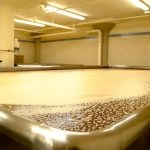Fermenting Their Place Into History
The upcoming MarketScale ‘American Craft’ series is showcasing some of the nation’s top craft breweries to discover how they disrupted a market long dominated by international conglomerates. Our first multi-media installment takes a look at Anchor Brewing in San Francisco, Calif.
Anchor Brewing in San Francisco, Calif. has one of the most unusual brewing methods in the country. Its fermentation process is built into a unique clean-room with four large shallow containers that each hold close to 100 barrels of beer. The expansive tubs are used to encourage more activity within the wort, soon to be beer.
This method is specific to the Bay Area. The region’s first brewers, at the turn of the 20th century, had to alter their process to address one big issue: the dearth of ice and refrigeration.
Today’s standard brewing process includes boiling a mixture of water, yeast, and hops, called wort, then bringing the temperature down rapidly. The preferred method of rapid cooling involves submerging the container into ice, or if it is a bigger batch of beer, using refrigeration techniques. However, in the late 1800s, both were hard to come by in the newly settled San Francisco area.
One of the ways Brewers improvised was by rethinking the fermentation process. Instead of closed vertical containers, they designed big, shallow open ‘coolships’ on top of rooftops, which let the ocean breeze do the work of cooling the beer. This process created an immense amount of steam, which prompted its nickname, steam beer.
For nearly 70 years, Anchor Brewing used the rooftop method of brewing.
“It is hard to imagine that some amount of seagull [excrement] didn’t end up in the batch,” current Anchor Brewmaster Scott Ungermann admits.
Eventually, the questionable sanitation conditions of brewing beer on rooftops would have to change to save the beer. During the 1960s, Anchor was building a reputation as, “a quirky little brewery that had inconsistent beer,” according to Ungermann.
Shuttering its doors seemed imminent until Fritz Maytag bought the brewery so he could continue to drink his favorite beer.
Maytag spent several years studying and perfecting the process of steam beer, which included moving to a bigger facility and bringing the fermentation process inside to maintain a consistent temperature throughout the process.
This temperature is the same today, and immediately noticeable when stepping into the fermentation room. Visitors are met with a 60-degree chill, which is symbolic of the average temperature of San Francisco.
“It allows the fermentation [process] to free-rise in temperature. The yeast will naturally heat up as fermentation takes off,” Ungermann said.
The activity of the yeast in the wort forms a head of foam at the top. The sides of the tank will be warmer (roughly 70-72 degrees) than the air in the room because of the chemical activity in the wort.
The temperature of this lager fermentation is considerably warmer than the standard process, which helps steam beer develop its unique qualities. The room has a unique smell as well.
“[It] is almost ester-y and ale-like,” Ungermann said. “People say that steam beer is really a hybrid style between lager and ale, but it is a lager because we use lager yeast,” Ungermann said.
During the fermentation process, the yeast collapses to the bottom of the fermenter into a shallow trough that can “catch” the yeast. The trough produces a solid strip in the middle of the top layer of the foam which signals where all the yeast has settled.
“The tank is designed to be very gentle on the yeast, there is no pressure on the tank,” Ungermann pointed out.
Visually, the beer is ready to “drop” when the top layer of foam has completely vanished and is smooth. There are more scientific analyses that the team can conduct, but the Anchor brewers are confident in their process.
“Visually [there is] a corresponding rhythm to the fermentation. Day one: foamy as heck. Day two: foam starts to settle. Day three: flat and ready to drop,” Ungermann said.
The iconic steam beer then goes through a secondary fermentation in another tank. Freshly yeasted wort will be added at a certain percentage to get a secondary fermentation process started in an enclosed vestal.
As the secondary fermentation process takes place, the beer organically begins to carbonate.
“We will have a naturally carbonated and beautifully aged beer by the end of another couple of weeks,” Ungermann said.
Anchor’s lagering process is quick by industry standards, taking a total 15 days. Three are spent in the initial fermentation and another 12 in a secondary vestal.
The yeast is kept in the fermentation room, creating a perpetual cycle.
As Ungermann notes, “if you’re nice to the yeast, the yeast will be good to you.”
On MarketScale’s American Craft podcast, take a step into Anchor Brewing’s learn how a company twice on its deathbed has become among the largest and most profitable craft breweries in the world.
For the latest news, videos, and podcasts in the Food & Beverage Industry, be sure to subscribe to our industry publication.
Follow us on social media for the latest updates in B2B!
Twitter – @FoodMKSL
Facebook – facebook.com/marketscale
LinkedIn – linkedin.com/company/marketscale










